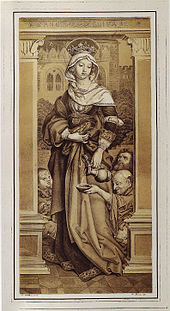Libellus de dictis quatuor ancillarum sanctae Elisabeth confectus

The Libellus de dictis quatuor ancillarum sanctae Elisabeth confectus ( little book of the statements of the four servants , hereinafter referred to as Libellus ) is one of the most important sources on the life of Elisabeth of Thuringia , who is venerated as a saint of the Catholic Church and patron saint of Hesse and Thuringia .
Together with the Summa Vitae of Konrad von Marburg, it gives detailed information about their lives. The Libellus contains the testimony of the four so-called servants who were heard in Marburg as part of the canonization process . The individuals whose statements are summarized in the Libellus are Guda , Isentrud von Hörselgau and the Marburg hospital nurses Irmgard and Elisabeth.
Guda had been living with Elisabeth von Thuringia, who was a year younger than her, from the age of five and later became one of her ladies-in-waiting . Isentrud von Hörselgau was one of the other ladies-in-waiting in the entourage of the Hungarian king's daughter and Thuringian countess. She describes much more vividly than Konrad von Marburg , Elisabeth von Thuringia's pastor and with his summa vitae her first biographer, their care for the poor and needy. Irmgard and Elisabeth worked together with Elisabeth von Thuringia in the Marburg hospital.
The three oldest biographies of Elisabeth of Thuringia, all of which were written in the first half of the 13th century, are based on the Libellus from 1235. In 1237 Caesarius von Heisterbach wrote a vita for Saint Elisabeth; two more, whose authors are not known by name, were written before 1240 in the vicinity of Emperor Frederick II and the papal curia . The special value of the Libellus is that it was written down as part of the canonization process and thus has the character of an official document.
A copy of the Libellus, which reliably goes back to the canonical acts, is available in the library of the seminary in Trier in the form of a parchment manuscript from around 1250 .
expenditure
- The so-called Libellus de dictis quatuor ancillarum S. Elisabeth confectus . Using all known manuscripts, published for the first time in full with a critical introduction and explained by Albert Huyskens . Munich 1911.
- Libellus de dictis quatuor ancillarum S. Elisabeth confectus. Booklet about the statements of the four servants . In: Elisabeth von Thüringen, edited and introduced by Walter Nigg , Düsseldorf 1963, pp. 69–107 ( full text ( memento of August 3, 2007 in the Internet Archive ))
literature
- Daria Barow-Vissilevitch: Elisabeth of Thuringia. Holy, queen of love, rebel . Jan Thorbecke Verlag, Ostfildern 2007, ISBN 978-3-7995-0177-4 .
- Paul Gerhard Schmidt: The contemporary tradition on the life and canonization of St. Elisabeth . In: Philipps University of Marburg (ed.): Sankt Elisabeth: Fürstin - Dienerin - Heilige . Jan Thorbecke Verlag, Sigmaringen 1981, ISBN 3-7995-4035-0 , pp. 1-7.
- Helmut Zimmermann, Eckhard Bieger: Elisabeth - saint of Christian charity . Publishing community Topos plus, Kevelaer 2006, ISBN 3-7867-8598-8 .
Web links
- Entry on Libellus in the repertory "Historical Sources of the German Middle Ages"
Remarks
- ↑ Barow-Vassilevitch, pp. 24-25; Schmidt, pp. 4-5.